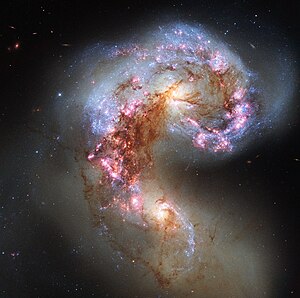Antennae Galaxies
| Antennae Galaxies | |
|---|---|
 NGC 4038 (left) and NGC 4039 (right) | |
| Observation data (J2000 epoch) | |
| Constellation | Corvus[1] |
| Right ascension | 12h 01m 53.0s / 12h 01m 53.6s[2] |
| Declination | −18° 52′ 10″ / −18° 53′ 11″[2] |
| Redshift | 1642 ± 12 / 1641 ± 9 km/s[2] |
| Distance | 45 Mly / 65 Mly |
| Apparent magnitude (V) | 11.2 / 11.1[2] |
| Characteristics | |
| Type | SB(s)m pec / SA(s)m pec[2] |
| Apparent size (V) | 5′.2 × 3′.1 / 3′.1 × 1′.6[2] |
| Notable features | Interacting galaxies |
| Other designations | |
| Ringtail Galaxy,[2] NGC 4038 / 4039,[2] PGC 37967 / 37969, Arp 244,[2] Caldwell 60/61 | |
The Antennae Galaxies, also known as NGC 4038/NGC 4039, are a pair of interacting galaxies in the constellation Corvus. They are currently going through a starburst phase, in which the collision of clouds of gas and dust, with entangled magnetic fields, causes rapid star formation. They were discovered by William Herschel in 1785.[3] NGC 4038 is located at RA 12h 01m 53.0s, Dec −18° 52′ 10″; and NGC 4039 at RA 12h 01m 53.6s, Dec −18° 53′ 11″.
General information

The Antennae Galaxies are undergoing a galactic collision. Located in the NGC 4038 group with five other galaxies, these two galaxies are known as the Antennae Galaxies because the two long tails of stars, gas and dust ejected from the galaxies as a result of the collision resemble an insect's antennae. The nuclei of the two galaxies are joining to become one giant galaxy. Most galaxies probably undergo at least one significant collision in their lifetimes. This is likely the future of our Milky Way when it collides with the Andromeda Galaxy.
Five supernovae have been discovered in NGC 4038: SN 1921A, SN 1974E, SN 2004GT, SN 2007sr and SN 2013dk.[4]
A recent study finds that these interacting galaxies are less remote from the Milky Way than previously thought—at 45 million light-years instead of 65 million light-years.[5]
They are located 0.25° north of 31 Crateris and 3.25° southwest of Gamma Corvi.[6]
Timeline
About 1.2 billion years ago, the Antennae were two separate galaxies. NGC 4038 was a barred spiral galaxy and NGC 4039 was a spiral galaxy. Before the galaxies collided, NGC 4039 was larger than NGC 4038.[citation needed] 900 million years ago, the Antennae began to approach one another, looking similar to NGC 2207 and IC 2163. 600 million years ago, the Antennae passed through each other, looking like the Mice Galaxies. 300 million years ago, the Antennae's stars began to be released from both galaxies. Today the two streamers of ejected stars extend far beyond the original galaxies, resulting in the antennae shape.
Within 400 million years, the Antennae's nuclei will collide and become a single core with stars, gas, and dust around it.[citation needed] Observations and simulations of colliding galaxies suggest that the Antennae Galaxies will eventually form an elliptical galaxy.[7]
X-ray source
Areas containing large amounts of neon, magnesium, and silicon were found when the Chandra X-ray Observatory analyzed the Antennae Galaxies. These elements are necessary in order for planets that may contain life to form. The clouds imaged contain 16 times as much magnesium and 24 times as much silicon as the Sun.
Gallery
-
Antennae Galaxies composite of ALMA and Hubble observations
See also
References
- ^ R. W. Sinnott, ed. (1988). The Complete New General Catalogue and Index Catalogue of Nebulae and Star Clusters by J. L. E. Dreyer. Sky Publishing Corporation and Cambridge University Press. ISBN 0-933346-51-4.
- ^ a b c d e f g h i "NASA/IPAC Extragalactic Database". Results for NGC 4038 / 4039. Retrieved 2006-12-07.
- ^ "Corvus". Universe Today. Retrieved 2006-12-07.
- ^ "List of Supernovae". IAU Central Bureau for Astronomical Telegrams. Retrieved 2015-08-22.
- ^ "The Antennae Galaxies Found To Be Closer To Us". Space Daily. 2008-05-12. Archived from the original on 17 May 2008. Retrieved 2008-06-30.
{{cite web}}: Unknown parameter|deadurl=ignored (|url-status=suggested) (help) - ^ O'Meara, Stephen James (2002). The Caldwell Objects. Cambridge University Press. pp. 240–43. ISBN 978-0-521-82796-6.
- ^ J. E. Barnes; L. Hernquist (1992). "Dynamics of interacting galaxies". Annual Review of Astronomy and Astrophysics. 30 (1): 705–742. Bibcode:1992ARA&A..30..705B. doi:10.1146/annurev.aa.30.090192.003421.
External links
- Astronomy Picture of the Day: The Antennae Galaxies (10/22/1997)
- Astronomy Picture of the Day: The Antennae (04/29/2011)
- Astronomy Picture of the Day: The Antennae (02/12/2015)
- The Register: Galactic prang fingered in star formation mystery
- ESA/Hubble News Release
- ESA/Hubble images of Antennae Galaxies
- Animations of galactic collision producing antennae structures
- Antennae Galaxies on WikiSky: DSS2, SDSS, GALEX, IRAS, Hydrogen α, X-Ray, Astrophoto, Sky Map, Articles and images
- Antennae Galaxies at Constellation Guide


